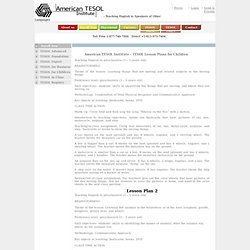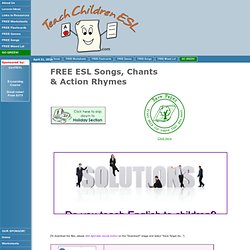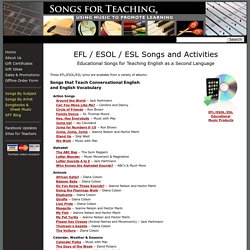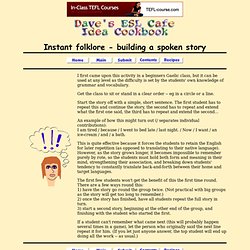

Please help me find ESL kindergarten lesson plans. Language Arts. Free online EFL / ESL Listening exercises: songs. TESOL Lesson Plans for Children - TESOL - Yahoo! News Search Results. Teaching English to preschoolers (3 – 5 years old) Theme of the lesson: Learning things that are moving and related subjects to the moving things.

Proficiency level: preschoolers (3 – 5 years old) Skill objectives: students’ skills in identifying five things that are moving, and where they are moving on. Methodology: Combination of Total Physical Response and Communicative Approach Key objects of learning: flashcards, books, DVD Warm Up: Circle time and then sing the song “Wheels on the Bus” with a motion. Introduction to teaching objectives: hands out flashcards that have pictures of car, bus, motorcycle, airplane, and ship. Teaching/in-class assignment: Using real miniatures of car, bus, motor-cycle, airplane, and ship, flashcards or books to show the moving things. A car moves on the land (ground) and has 4 wheels, engines, and 1 steering wheel. A bus is bigger than a car. A motorcycle is smaller than a car or a bus. An airplane flies on the sky, up and above. A ship sails on the water. TESOL Lesson Plans for Children - TESOL - Yahoo! News Search Results. Happy and you Know it - refresher. I find that one of the most terrifying things is when you are completely done with the lesson and you still have 10 minutes to go, and reviewing the lesson would go over about as well as giving an inspirational talk on how marching on the Trail of Tears was great for the Native Americans quads, calves, and burning unwanted pounds... it wouldn't go well.

Review is fun! Animal Nicknames. This works best with intermediate to advanced kids (not so much english for the advanced ones) Before class make up a sheet of paper with all of the students names on it with a blank line next to each name.

Include your own name also. Hand these out to the students in class. Then tell them to look carefully at each of their other students. Tell them that their job is to think of what kind of animal that each of the students resemble and why. This game had some of my students holding their sides in laughter and also allowed the students to feel much more comfortable with one another. Name: Gavin PurcellEmail: gpurcell@uriel.netLocation: Seoul, Korea.
"What's in the bag....?" Simple yet practical exercise.

I use it for kindergardeners through 7-8 year olds. Any plastic bag will do. Collect various objects- a coin, watch, ring, scissors, a battery, medicine, etc.... I simply say"Whats in the bag? " The kids usually parrot this back to me. Migook InCh'ongju, S. As cute as a kitten. ESL Kids. Lesson plans. A set of lesson plans and worksheets for use in first lessons in business English.

As you look at the lesson plan and worksheets, use the wish list grid to tick off the points on the ‘Wish list’ you think they achieve. Does the number of ticks really denote a good lesson? Further suggestions Depending on the materials used, the materials and lesson plan provided here seem to cover all the points down to number 21 (learn something about how to study English).This point could be added by providing students with a language reference section on numbers or tenses to check their answers against before going through it as a class.Tips on self-study (22) could be added simply by telling the students where these language reference sections came from and where they can buy the book.Homework (25) could be practice exercises from the same or a similar book. TESOL Lesson Plans for Children - TESOL - Yahoo! News Search Results. 07-45-2-amazinganimals. 07-45-2-f. Elementary School Games and Activities. The EFL Playhouse: Resources for ESL/EFL Teachers of Young Learners. Teach Children ESL - Songs, Chants, and Action Rhymes.
FREE ESL Songs, Chants& Action Rhymes [To download the files, please click right-side mouse button on the "Download!

" image and select "Save Target As... "] Get Involved! The more the better, so if you want to get involved directly, please feel free to contact us. If you have articles you want published, a related website to promote, worksheets, lesson ideas, or anything else you want to share, please talk to us. Old Lady Who Swallowed a Fly. Lesson Plan Helper for ESL kids classes. EFL / ESOL / ESL Educational Songs and Activities: Song Lyrics for Teaching English as a Second Language.
These EFL/ESOL/ESL lyrics are available from a variety of albums: Songs that Teach Conversational English and English Vocabulary Action Songs Around the World – Jack Hartmann Can You Move Like Me?

– Caroline and Danny Circle of Friends – Ron Brown Family Dance – Dr. . – Music with Mar. . – Jay Cleveland Jump for Numbers 0-10 – Ron Brown Jump, Jump, Jump. All God's Creatures Have A Place In The Choir song and lyrics from KIDiddles. Flashcards, Worksheets, Games and Songs. Teaching English to Children: Gogo Loves English. Lesson Plan Helper for ESL kids classes. TESOL Lesson Plans for Children - TESOL - Yahoo! News Search Results. Games. POSTER: 7 Easy Icebreakers You Can Do With Post-It Notes. Instant folklore - building a spoken story. I first came upon this activity in a beginners Gaelic class, but it can be used at any level as the difficulty is set by the students' own knowledge of grammar and vocabulary.

Get the class to sit or stand in a clear order -- eg in a circle or a line. Start the story off with a simple, short sentence. The first student has to repeat this and continue the story, the second has to repeat and extend what the first one said, the third has to repeat and extend the second... An example of how this might turn out (/ separates individual contributions):I am tired / because / I went to bed late / last night. / Now / I want / an ice-cream / and / a bath. This is quite effective because it forces the students to retain the English for later repetition (as opposed to translating to their native language). The first few students won't get the benefit of this the first time round.